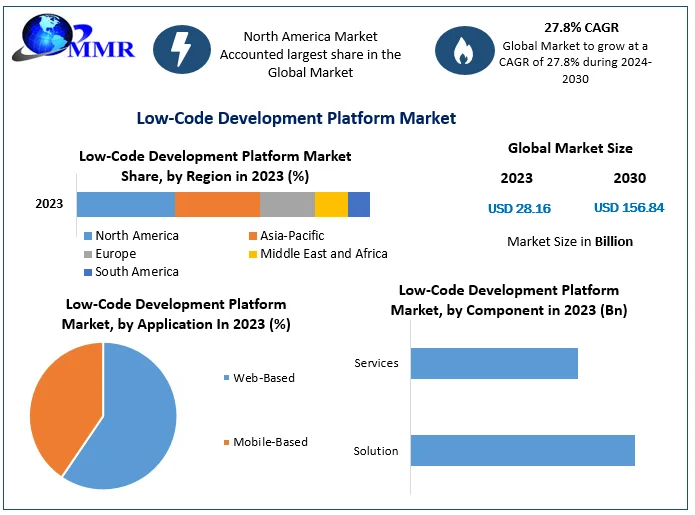Free News For Choosing Low-code platforms for application development
Free News For Choosing Low-code platforms for application development
Blog Article
Benefits Of Low-Code Application Development For Developers Who Are Not Developers.
Due to a range of important factors, Low-Code Application Development is available to people who are not developers. They are also known as "citizen designers."
Drag-and-Drop Builders: Low-code platforms have drag-and-drop interfaces that allow non-developers to design applications without needing to write code. The process of developing applications is now more accessible to those with no technical background.
WYSIWYG Editors: "What You See Is What You Receive" editors enable users to create interfaces and workflows in a manner that closely resembles the final product, making it easier to comprehend and use.
Simplified workflow and logic
Visual Workflow Design: Users are able to quickly design business processes and application logic by using flowcharts, models and diagrams. They are easier to use than traditional programming.
Low-code platforms typically come with pre-built logic components (e.g. the conditional loops, statements) which eliminate the need for complicated programming.
Templates and components that are reuseable:
Library of pre-built templates: Many Low-Code platforms have templates that are based on typical application types. Developers who are not developers will be in a position to modify these templates, if required.
Reusable Widgets and Modules: With the help of modular and widgets that can be reused, users can simplify the design process while reducing their need for technical expertise.
Guided Development and Tutorials
Step-by-step guide Platforms offer tutorials, tips and tricks on the screen and development guides to help non-developers build applications.
Interactive Tutorials. Interactive, hands on tutorials allow users to gain knowledge by doing.
Integration with Existing Tools:
Easy Integration - Low-code platforms can easily be integrated with existing systems and business tools (e.g. ERP CRM) that give even non-developers to create apps that fit into their workflows.
APIs and Connectors APIs built-in and connectors simplify the integration process and allow non-developers to connect their applications to external services without the need for complicated coding.
Collaboration Features:
Team Collaboration Features, such as real-time collaboration and shared workspaces, allow professionals and non-developers to collaborate efficiently.
Role-based Access Control: Developers are assigned roles with appropriate access levels, ensuring that they can participate in the process of development without having to compromise security or function.
Automated Testing and Debugging
Low-code platform often comes with a built-in testing and debugging tool that automates this process. Developers who are not developers can now make sure that their applications are working properly.
Error Highlighting When errors occur, the platform highlights these and suggests solutions. It assists non-developers with solving the issue.
Low-code development is more accessible to non-developers as it allows for democratization of the development process. With its an intuitive, visually-guided tool and experiences, low code platforms enable business owners to actively take part in and manage applications. Check out the most popular Low-code Platform for application development for website advice including app platforms, cross platform app dev, azure sql server, azure sql, paas service, ms azure sql, develop cross platform mobile app, app platforms, push alerts, azure sql and more.
Low-Code Application Development Offers Many Benefits In Terms Of Cost-Effectiveness.
Low-code app development offers many advantages, such as cost-effectiveness. It is a popular option for businesses who want to reduce development costs without sacrificing quality. These are the main benefits: Reduced development costs:
Lower requirements for coding: Low code platforms eliminate the need for lengthy, hand-coded applications. Developers are able to take less time and energy developing apps. The result is lower labor costs.
Reduced Developer Resources: Since low-code is more efficient and less time to create, less skilled developers will be required. This will reduce the costs of recruiting and retaining personnel.
Time to market faster:
Accelerated Development Cycle Visual development tools and pre-built components offered by low-code platforms allow for rapid development of applications, which allows companies to get their products on the market more quickly. This can lead to faster revenue generation as well as improved positioning in the market.
Rapid Prototyping. Businesses can quickly test and create prototypes. This helps reduce time during the development phase, and allows for quicker iterations based on feedback from users.
Lower Maintenance Costs:
The modular design and standard components of apps developed using low-code platforms make them easy to maintain. It reduces maintenance and support costs.
Automated Updates. A lot of low-code platforms handle patches and updates automatically. Applications remain safe without requiring a lot of manual input.
Efficient Resource Utilization:
Non-Developer contributions: Low code platforms empower non-developers, such as business users, to be a part of the process of development. This makes it possible for companies to benefit from the talents of a diverse range of employees.
Utilizing IT resources efficiently: IT departments will be able to concentrate on strategic initiatives, instead of being bogged down in mundane development tasks. This will boost overall efficiency and productivity.
The Scalable Pricing models
Subscription-Based Pricing: A lot of low code platforms offer an affordable subscription-based pricing model that grows according to usage. This lets businesses be able to align their spending with the actual demands and growth, while avoiding huge up-front costs.
Pay-as-you-go: Certain platforms provide pay-as-you-go options. This allows businesses to only pay for resources they actually need. This is especially beneficial for small businesses and startups with a limited budget.
Cost reductions of third-party software:
Low-code platforms are built-in with functions and integrations, which could reduce the cost of software subscriptions and licensing.
Pre-Built Integrations: Having pre-built intiations with popular services and systems reduces the need for custom-designed development. Time savings and money.
Improved ROI:
A faster return on investment: The combination of speedy development, less expensive and a faster time to market means businesses will see a higher return on investment (ROI) on their software.
Improved Agility - Businesses can quickly adapt to changes in the market and changing customer needs. This helps them remain current and take advantage of opportunities that arise.
Lower Cost of Training:
User-Friendly Interfaces: Low-code platforms are user-friendly and have simple interfaces, which reduces the time required to learn.
Accessible Resources - Many low-code platforms offer complete instructional materials and tutorials along with community support. These resources eliminate the requirement for formal instruction and the associated cost.
Streamlined Collaboration:
Improved Collaboration Tools: Built-in collaboration tools facilitate better communication and coordination between team members, leading to improved development efficiency and a reduction in project costs.
Unified Development Environment : A unified environment streamlines workflows and reduces the costs associated with managing various platforms and tools.
Low-code development is cost-effective because it decreases maintenance and development expenses. It also speeds up the time to market and maximizes resource usage. Pricing models can be adapted. This combination of factors offers firms significant financial benefits and makes low-code an appealing choice for companies looking to make the most of their budgets for development, while still creating strong and scalable applications. Have a look at the top rated her comment is here for Legacy application modernization with Low-code for more advice including rapid app development, mobile app development platforms, application modernisation, develop mobile application, push notifications, develop mobile application, paas service, microsoft azure sql, push alerts, low code development platforms and more.
Benefits Of Low-Code Application Development In Terms Of Community Support And Vendor Support
Low-code platform development has many advantages, including support from vendors and a community support. This is crucial in ensuring successful application development as well as ongoing maintenance and constant improvement. Here are the major advantages: Support from vendors
Comprehensive Technical Support:
Support Teams Dedicated to You: A lot of low-code software platforms offer access to support teams that can help with technical issues, troubleshooting, and help, making sure that all issues are solved quickly.
24/7 Support: Some vendors are available all hours of the day and this is helpful for businesses that operate in multiple time zones.
Training and Onboarding:
Vendors offer structured training programs such as webinars, tutorials, and certificates to help users get familiar with the platform.
Personalized Onboarding: Many vendors offer customized onboarding services that help new customers use the platform in a way that is effective and customize it to their specific needs.
Regular Updates, Enhancements, and Enhancements:
Continuous Improvements: Low-code vendors frequently release updates, which include performance improvements as well as new features and security patches, in order to ensure that the platform is up-to-date.
Feedback integration: Vendors will often incorporate user feedback into their process of development to ensure that their platform meets the evolving needs of the users.
Comprehensive Documentation:
Documentation is detailed users are able to access extensive and well-organized documents, ranging in complexity from simple modification to advanced.
API References API documentation can help developers build and integrate apps using the Low-Code platform.
Professional Services and Consulting
Expert Consulting: Many vendors offer consulting services to help with architectural planning, strategic planning and complicated implementations. This allows users to maximize the platform's potential.
Custom Development Services Some vendors provide custom development services to develop specific integrations and features that aren't available in the standard.
Community Support for the Community
Active User Communities
Discussion boards and forums Forums and discussion boards: A lot of low code platforms have vibrant online communities that let users discuss issues, share solutions and collaborate on best practice.
Virtual and local User Groups: These groups give you the chance to network, learn and share knowledge.
Collaboration and Knowledge Sharing
Community-Contributed Resources: Users often share templates, modules, and extensions that they have developed, which can be reused or adapted by others, accelerating development and innovation.
Crowdsourced Problem Solving: The collective expertise and experience of the crowd can be a valuable source of troubleshooting and finding innovative solutions to difficult issues.
Learning and development:
Community-Led Training: Many communities organize workshops, training sessions and webinars. These are usually conducted by experienced users who share practical knowledge and advanced techniques.
Tutorials and Online Courses Community members regularly develop and publish online courses, tutorials, and how-to guides, improving the educational resources that are available to all users.
Feedback and Influence
Product Feedback Channels. Community forums typically include channels that allow users to give feedback to the vendor. This feedback may influence the development and enhancement of features.
Beta Testing Programmes Members of the community who are active could get the chance to take part in beta testing programs. This gives them an early view on new features as well as an opportunity to contribute to the platform’s evolution.
Recognition and Support
Community Recognition Programs - A lot of companies offer recognition programs that recognize the contributions made by active members of their communities such as MVP (Most Valuable Professionals) programs.
Peer Support : Members of the community give support to each other by sharing their experiences and providing advice. They build a supportive and supportive environment by sharing knowledge.
The combination of robust vendor support, and an active and engaged community creates a broad ecosystem of support for development with low-code. The combination of strong vendor support and an active, engaged community provides an entire support network for low-code application development.